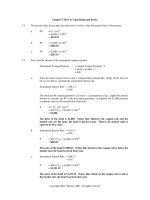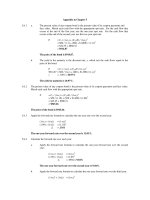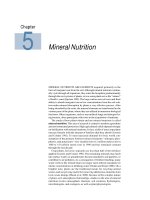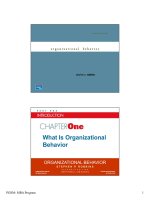Organizational behavior chapter 5 motivation
Bạn đang xem bản rút gọn của tài liệu. Xem và tải ngay bản đầy đủ của tài liệu tại đây (223.21 KB, 23 trang )
Chapter 5
MOTIVATION
For use with Organizational Behaviour and Management
by John Martin and Martin Fellenz
1408018128© 2010 Cengage Learning
Motivation and performance
Motivation - the force that initiates, directs and sustains
behaviour
Ability - the capacity of individuals to achieve the tasks they are
trying to accomplish
Opportunity - the conditions under which motivation and ability
are deployed
For use with Organizational Behaviour and Management
by John Martin and Martin Fellenz
1408018128© 2010 Cengage Learning
Basic motivational process
Add Figure 5.1 here
For use with Organizational Behaviour and Management
by John Martin and Martin Fellenz
1408018128© 2010 Cengage Learning
Motivation in organizations
Motivation explains three important aspects of deliberate
behaviour:
Direction - the type of activity chosen to be engaged with
Effort - the amount of energy expended in relation to a particular
activity
Persistence - the duration of the behaviour in question, especially
in light of difficulties or obstacles
For use with Organizational Behaviour and Management
by John Martin and Martin Fellenz
1408018128© 2010 Cengage Learning
Intrinsic and extrinsic motivation
Intrinsic motivation - the impetus for behaviour
originates in the performance of the action itself,
such as an enjoyable or otherwise satisfying task
Extrinsic motivation - the impetus for behaviour
originates outside the person and the performed
task, it is done as a means to another end
For use with Organizational Behaviour and Management
by John Martin and Martin Fellenz
1408018128© 2010 Cengage Learning
Content theories of motivation
Maslow’s hierarchy of needs theory
Alderfer’s existence, relatedness and growth theory (ERG)
Herzberg’s two-factor theory
For use with Organizational Behaviour and Management
by John Martin and Martin Fellenz
1408018128© 2010 Cengage Learning
Maslow’s hierarchy of needs
Individuals have innate needs or wants which they will seek to
satisfy
• Physiological needs
• Safety needs
• Social needs
• Esteem needs
• Self-actualization needs
For use with Organizational Behaviour and Management
by John Martin and Martin Fellenz
1408018128© 2010 Cengage Learning
Maslow’s hierarchy of needs
Hierarchy displays the following properties:
• A need once satisfied is no longer a motivator
• A need cannot be effective as a motivator until those before
it in the hierarchy have been satisfied
• If deprived of the source of satisfaction from a lower order
need it will again become a motivator
• There is an innate desire to work up the hierarchy
• Self-actualization is not like the other needs
For use with Organizational Behaviour and Management
by John Martin and Martin Fellenz
1408018128© 2010 Cengage Learning
Maslow’s hierarchy of needs
• Figure 5.2
For use with Organizational Behaviour and Management
by John Martin and Martin Fellenz
1408018128© 2010 Cengage Learning
Alderfer’s ERG theory
Three-level hierarchy:
• Existence needs
• Relatedness needs
• Growth needs
For use with Organizational Behaviour and Management
by John Martin and Martin Fellenz
1408018128© 2010 Cengage Learning
Herzberg’s two-factor theory
Motivators and hygiene factors
Hygiene factors if absent cause dissatisfaction
• Salary
• Working conditions
• Job security
• Level and quality of supervision
• Company policies and administrative procedures
• Interpersonal relationships at work
Motivators - motivate an individual to improve their work performance
• Recognition
• Sense of achievement
• Responsibility
• Nature of the work itself
• Growth
• Advancement
For use with Organizational Behaviour and Management
by John Martin and Martin Fellenz
1408018128© 2010 Cengage Learning
Comparison of the needs theories
Figure 5.3
For use with Organizational Behaviour and Management
by John Martin and Martin Fellenz
1408018128© 2010 Cengage Learning
Satisfaction and Herzberg’s two factors
• Figure 5.4
For use with Organizational Behaviour and Management
by John Martin and Martin Fellenz
1408018128© 2010 Cengage Learning
Process theories
Vroom Porter and Lawler expectancy models
Adam’s equity theory
Locke’s goal theory
For use with Organizational Behaviour and Management
by John Martin and Martin Fellenz
1408018128© 2010 Cengage Learning
Vroom’s expectancy model
• Figure 5.5
For use with Organizational Behaviour and Management
by John Martin and Martin Fellenz
1408018128© 2010 Cengage Learning
Porter and Lawler expectancy model
• Figure 5.6
For use with Organizational Behaviour and Management
by John Martin and Martin Fellenz
1408018128© 2010 Cengage Learning
Adam’s equity theory
• Relative fairness of treatment
at work
• Equity/Inequity
Figure 5.7
For use with Organizational Behaviour and Management
by John Martin and Martin Fellenz
1408018128© 2010 Cengage Learning
Locke’s goal setting theory
Intentions play a significant part in behavioural patterns
Feedback
Figure 5.8
Goal setting needs:
• Specifics
• Completion requirement
• Difficult goal/easy goals
SMART objectives
For use with Organizational Behaviour and Management
by John Martin and Martin Fellenz
1408018128© 2010 Cengage Learning
BEHAVIOURIST THEORIES
Pavlov and classical conditioning
Skinner and operant conditioning
For use with Organizational Behaviour and Management
by John Martin and Martin Fellenz
1408018128© 2010 Cengage Learning
Pavlov and classical conditioning
• Figure 5.9
For use with Organizational Behaviour and Management
by John Martin and Martin Fellenz
1408018128© 2010 Cengage Learning
The four central processes used in
operant conditioning
•Figure 5.10
For use with Organizational Behaviour and Management
by John Martin and Martin Fellenz
1408018128© 2010 Cengage Learning
RECENT CONTRIBUTIONS TO WORK
MOTIVATION
•
Bandura’s Social-Cognitive Theory
– Important aspects of this theory include:
• the notion of vicarious learning
• dynamics of self-control (absent from behaviouristic views of
behaviour)
• the concept of self-efficacy
•
Self-Determination Theory
– distinguishes between:
• autonomous motivation (where behaviour is based on volition and
active choice)
• controlled motivation (where behaviour is based on external
consequences determined by decisions or dynamics outside the
person)
For use with Organizational Behaviour and Management
by John Martin and Martin Fellenz
1408018128© 2010 Cengage Learning
Continuum of self-determination
according to SDT
• Table 5.1
For use with Organizational Behaviour and Management
by John Martin and Martin Fellenz
1408018128© 2010 Cengage Learning









